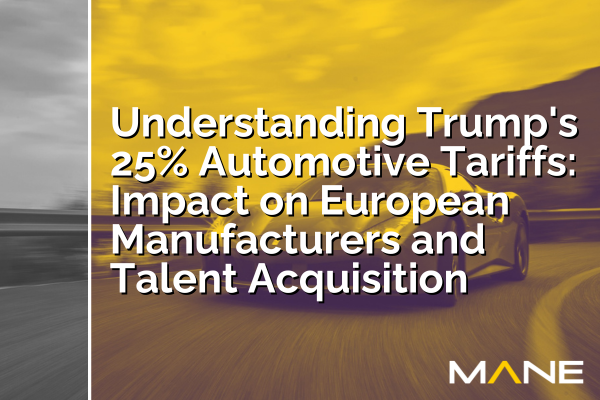Understanding Trump's 25% Automotive Tariffs: Impact on European Manufacturers and Talent Acquisition
11 Apr, 20254 minsPresident Trump's implementation of a 25% tariff on automotive vehicles entering the US has ...

President Trump's implementation of a 25% tariff on automotive vehicles entering the US has sent ripples through the global automotive industry. Despite his recent announcement of a 90-day pause on reciprocal tariffs, it's crucial to note that the 25% tariff on non-US cars remains firmly in place. This distinction is creating significant confusion in markets worldwide.
A recent analysis by the Center for Automotive Research has found that these tariffs will increase costs by approximately $108 billion for automakers in the US in 2025 alone. The study specifically found that Detroit automakers (Ford, GM, and Stellantis) will face increased costs of $42 billion, with tariffs of nearly $5,000 for parts they import for each US-produced car and about $8,600 on average for each car they import.
While US manufacturers grapple with these figures, the effects on European and UK manufacturers are equally - if not more - significant, with the EU automotive industry facing tariffs affecting up to €67 billion in exports.
The Current State of Play
Trump's 25% tariffs on automotive vehicles and components entering the US include imports from both the UK and Europe, with additional 10% tariffs on all other UK imports and 20% tariffs on all other EU imports. These tariffs took effect on 3 April 2025, creating immediate challenges for manufacturers globally. Vehicles made in Mexico and Canada face the levy as well, though automakers compliant with the terms of the US-Mexico-Canada Agreement can deduct the value of US content.
The scale of potential impact is substantial. For context:
- The UK exported more than 101,000 vehicles to the US last year, worth £7.6 billion (representing 16.9% of UK car exports)
- The EU exported finished passenger cars and light trucks worth €39 billion (approximately 750,000 units) to the US
- Over a fifth of EU vehicle exports go to the US, with two-thirds of that total coming from Germany
German manufacturers are particularly vulnerable, accounting for nearly 65% of the EU's auto exports. Companies like Volkswagen, BMW, and Mercedes have each lost between 6-8% of their share value in the immediate aftermath of the tariff announcement. The situation has created what industry insiders are calling a "fundamental turning point in trade policy" for the European car industry, with reports of paused shipments, urgent dialogues with policymakers, and stock markets in limbo.
Impact on European Manufacturers
Germany: The Hardest Hit
German car manufacturers face perhaps the most significant challenges from these tariffs. As the EU's leading car exporter, Germany accounts for nearly two-thirds of the bloc's auto exports to the US.
"The new US tariffs pose a serious threat to globally integrated industries with complex supply chains such as the automotive sector," Dr. Sonali Chowdry, Research Associate at the German Institute for Economic Research (DIW) told Euronews Business. The president of the German Association of the Automotive Industry (VDA) Hildegard Müller has called the tariffs a form of "protectionism" that "will have negative effects on economic growth worldwide" and "affect jobs".
Major German manufacturers now face difficult choices:
- Volkswagen Group: Despite having 6 production sites in the US, VW still imports about two-thirds of the cars it sells in the US market, including from its Mexican plant which makes the Tiguan. VW has invested more than $14 billion (€12.8 billion) into the US market recently, with 7% of their global workforce employed in the country. The company sold approximately 379,000 vehicles in the US in 2024, a 15% increase from the previous year, but this represents only a fraction of the 9 million units sold worldwide. VW has stated: "US tariffs and any counter-tariffs will have negative consequences for growth and prosperity in the US and other economic areas."
- Audi (part of VW Group): The company makes none of its cars in the US or its engines. Audi models are mostly assembled in the EU, which appears far from reaching a trade deal with the US. Its best-selling car, the Q5, is built in Mexico, which was originally chosen because of NAFTA and its successor agreement.
- BMW: The company has announced it would temporarily absorb tariff costs on its Mexican imports but expects tariffs to impact earnings by $1.1 billion this year. BMW has one plant in South Carolina, which is reportedly at full capacity.
- Mercedes-Benz: Currently absorbing the 25% tariff on its 2025 models but will likely need to adjust pricing or production strategies longer-term. The carmaker sold more than 374,000 vehicles in the US in 2024, out of 2.4 million worldwide. Mercedes-Benz has held operations in the US since 1888 and directly and indirectly employs approximately 163,000 people at 24 locations across 13 states.
About a quarter of German auto exports to the US are cars shipped by German firms to their own American subsidiaries. "Disruptions to these within-company trade flows harm EU exports as well as operations of these businesses in the US," notes Dr. Chowdry.
UK Manufacturers: Mixed Fortunes
The impact on UK manufacturers varies considerably depending on their export profile and manufacturing footprint:
- Jaguar Land Rover (JLR): Approximately a quarter of JLR's production goes to the US, and with no plants there, it will be significantly impacted. Even if the UK negotiates a trade deal with the US, popular models like the Defender are made in Slovakia (EU), complicating matters. JLR has already decided to pause shipments while sizing up the effects of the tariffs - a significant decision given the volume of their US exports.
- Rolls-Royce: Despite its quintessentially British image, Rolls-Royce uses German engines and many other components. This means that even if the UK eventually secures a trade deal with the US, Rolls-Royce won't see the full benefit, and its US customers will likely face higher prices.
- McLaren: These luxury sports cars may weather the storm better than mass-market manufacturers. A McLaren spokesperson told Top Gear that the "handmade in Britain" cachet matters significantly to US buyers, who may be willing to absorb the additional costs, especially given the lack of direct US competitors. If Britain does secure a trade deal to reduce the 25% tariff while the EU doesn't, McLaren could potentially gain ground against European competitors like Ferrari, Porsche, Lamborghini, and AMG-Mercedes.
- Aston Martin: Similar to McLaren, Aston Martin's luxury positioning may provide some insulation from tariff impacts. The company's "perma-cheerful" boss Adrian Hallmark has taken a philosophical approach, reportedly saying "never waste a crisis, accelerate into it with optimism and a plan" - drawing on his experience steering Bentley through the dual challenges of Brexit and Covid.
- Mini: Despite selling Chinese-made EVs in other markets, Mini's US exports come from the UK (hatch) and Germany (Countryman) with mostly British engines. This leaves them particularly exposed to the tariffs, especially as they compete in the US with domestically-made cars from Japanese, Korean, and US brands.
- Lotus: While Chinese-made cars rarely make it to the US market, the Lotus Eletre and Emeya, produced in a factory in Wuhan, are among those affected by the tariffs.
Supply Chain Disruption and Strategic Responses
The automotive sector has historically been one of the most globally integrated industries, with interconnected supply chains meaning vehicles are designed and developed in one country, their components produced in others, and they are assembled in yet another country. These tariffs are forcing companies to reconsider their entire operational structure.
The tariffs have already triggered tangible responses. Stellantis (maker of Jeep and Ram trucks) has announced a temporary halt in production in Mexico and Canada, a move that has affected five US facilities connected to these operations. GM has increased truck output at an Indiana plant in response to the new trade environment.
Strategic responses across the industry include:
- Localisation of Manufacturing: Companies without US manufacturing presence are considering establishing or expanding production facilities in the US. Those already manufacturing in the US are looking to localise their supply chains. As legal experts at Shoosmiths LLP and Heuking Kühn Lüer Wojtek note, "The reallocation of production has to be planned and implemented carefully, taking into account regulatory, contractual and factual aspects such as conformity of production, quality and certification."
- Supply Chain Restructuring: Manufacturers are mapping their entire supply chains to understand where components originate and how tariffs will impact costs. This is creating pressure on smaller suppliers who may struggle with reduced margins. Even OEMs that already produce in the US rely on suppliers from neighbouring countries like Canada and Mexico and will see tariffs hit their supply chain.
- Temporary Cost Absorption: Some manufacturers, particularly in the premium segment, are temporarily absorbing the tariff costs rather than passing them on to consumers immediately. However, this is not sustainable long-term and will eventually result in price adjustments, reduced margins, or production shifts.
- Market Reorientation: Some manufacturers might pivot to focus more heavily on European and Asian markets. Research by Startline Motor Finance found that 59% of drivers say they are less likely to buy a car from a country imposing tariffs, potentially creating new opportunities in domestic markets.
- Corporate Partnerships: Longer-term strategies include joint ventures with US firms to develop a US footprint, which could help with reducing costs through shared distribution networks and warehousing.
- Workforce Restructuring: In line with pressure to reallocate and adapt production and supply chains, manufacturers are evaluating their workforce needs. Shoosmiths' employment team has already highlighted the potential impact of workforce restructuring in 2025 as a consequence of falling demand, and the tariff situation is likely to exacerbate these pressures.
Impact on Talent Acquisition and Workforce Management
The tariff situation is creating significant implications for talent acquisition and workforce management across the automotive sector, particularly for European manufacturers with global operations:
Shifting Skill Requirements
As manufacturers consider localising production, the skills profile they require is changing:
- Manufacturing Engineering: Increased demand for engineers with experience in setting up and optimising production lines as companies establish or expand US facilities. Companies like Volkswagen, with its significant US investment of over $14 billion, will need engineering talent to maximise their US manufacturing footprint.
- Supply Chain Expertise: Growing need for professionals who understand global trade regulations and can navigate complex tariff structures. This includes specialists in customs compliance, tariff classification, and rule of origin determinations who can help minimise duty exposure.
- Digital Skills: Accelerated adoption of automation and digital manufacturing to offset increased costs, creating demand for specialists in robotics, AI, and digital twin technologies. The pressure to maintain competitiveness despite higher costs will drive investment in efficiency-enhancing technologies.
- Legal and Compliance Skills: Increased demand for professionals who understand the regulatory aspects of supply chain changes and can ensure compliance with local content requirements, certification standards, and manufacturing regulations in different jurisdictions.
Geographic Talent Shifts
The reallocation of production is creating new talent dynamics:
- Reduced European Headcount: European facilities may see workforce reductions as production is reallocated to the US. German manufacturers, who account for 65% of the EU's auto exports to the US, may be particularly affected.
- US Talent Competition: European manufacturers expanding in the US will compete with domestic manufacturers for talent, potentially driving up wages in key roles. Companies like Mercedes-Benz, which already employs 163,000 people across 24 US locations, may need to expand their American workforce further.
- Supply Chain Roles: New opportunities in logistics and supply chain management as companies reconfigure their networks. This includes positions focused on strategic sourcing from countries with favourable trade agreements with the US.
- Specialised Roles in Trade Compliance: Growing demand for professionals who understand trade agreements, tariff regulations, and customs procedures to help manufacturers navigate the increasingly complex trade environment.
Talent Retention Challenges
The industry flux creates retention challenges:
- Job Security Concerns: Employees in European facilities, particularly those involved in production destined for US export, may worry about long-term job security, increasing turnover risk.
- Competitive Poaching: Manufacturers expanding US operations may target experienced staff from competitors, increasing talent mobility. Companies like Bosch, which has confirmed plans to "significantly expand our presence in the US," will be competing for talent.
- Skills Development Pressure: Existing employees need rapid upskilling to adapt to changing production methods and technologies. This includes cross-training workers to handle multiple aspects of production to increase flexibility.
- Global Mobility Challenges: Manufacturers looking to relocate key talent from Europe to the US may face challenges related to visa restrictions, family relocation issues, and compensation differentials.
Strategic Talent Acquisition Approaches
Forward-thinking manufacturers are adapting their talent strategies:
- Skills-Based Hiring: Moving beyond traditional automotive experience to focus on transferable skills from adjacent industries. This approach can help address talent shortages in key areas affected by production shifts.
- Distributed Teams: Leveraging remote work for design, engineering, and administrative functions while localising production. This allows companies to maintain centres of excellence in Europe while expanding manufacturing in the US.
- Education Partnerships: Collaborating with technical schools and universities to develop talent pipelines aligned with future needs. Companies with established US presence, like Mercedes-Benz with its 135-year history in the country, may leverage these relationships to expand their talent pool.
- Internal Mobility Programs: Creating pathways for European staff to relocate to US operations, preserving institutional knowledge while expanding US production capabilities.
- Flexible Workforce Models: Increasing use of contractors and temporary workers to maintain agility during transition periods. This approach allows manufacturers to scale up or down quickly as they adjust to the new tariff environment.
- Retention Focus: Implementing targeted retention strategies for key talent in European operations to prevent knowledge loss during the transition period.
Future Outlook
While these tariffs create immediate challenges, they also accelerate trends that were already underway in the automotive industry. The push toward localisation, digital transformation, and workforce flexibility was happening before the tariffs - but is now moving at an accelerated pace.
Several potential scenarios could emerge:
- Negotiated Resolution: The European Commission is in negotiations with the US, suggesting that tariffs could be lowered on both sides of the Atlantic in a "zero-for-zero" deal. As Sigrid de Vries, Director General of The European Automobile Manufacturers Association (ACEA), urges, finding common ground with the US and avoiding countermeasures will be crucial for European competitiveness.
- Permanent Production Shift: European manufacturers may permanently reallocate production, creating a more regionalised automotive industry with production closer to end markets. Companies like Bosch, the world's largest car parts supplier, have confirmed plans to "significantly expand our presence in the US, where we see big potential."
- Supply Chain Innovation: The pressure to reduce costs could accelerate innovation in manufacturing processes and supply chain management, potentially creating efficiencies that outlast the tariff situation.
- Market Segmentation: Premium European brands may continue to serve the US market despite tariffs, while mass-market vehicles become more regionally produced and distributed. This appears to be the strategy for companies like McLaren and Aston Martin, which are banking on their luxury status to weather the tariff storm.
- Trade Diversification: As Dr. Sonali Chowdry from the German Institute for Economic Research suggests, "A strategic response should focus on deepening ties with existing trade partners such as Canada, Mexico, Japan, and South Korea, while actively negotiating new agreements to diversify export markets." DIW simulations suggest that even modest reductions in trade barriers with these countries could offset the economic damages of a prolonged tariff conflict with the US.
The 25% automotive tariffs represent a significant challenge for European manufacturers, and contrary to some reports, these tariffs remain firmly in place despite the 90-day pause on reciprocal tariffs. The industry faces a complex and evolving trade landscape that will require strategic thinking and agile responses.
For manufacturers, the path forward involves careful consideration of production footprint, supply chain resilience, and talent strategy. Those that adapt quickly to the new reality - balancing localisation with global efficiency - will likely emerge stronger.
For talent acquisition professionals specifically, this represents both a challenge and an opportunity. Those who can help their organisations rapidly acquire the skills needed for this transition will play a crucial role in determining which manufacturers emerge strongest from this period of industry transformation.
The coming months will be telling as manufacturers implement their strategic responses and governments continue trade negotiations. What's certain is that the automotive landscape - both in terms of production footprint and talent needs - will look quite different in five years than it does today, with a likely acceleration toward more regionalised production and greater emphasis on workforce flexibility and digital skills.



